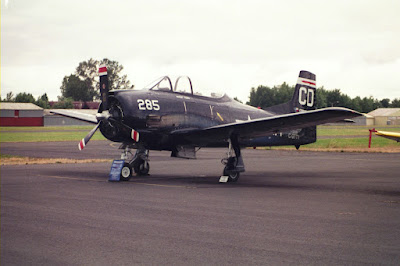In July 2005, Mothers of Military Support organized a 3-day Fly-In at Molt Taylor Field at the Kelso-Longview Regional Airport in Kelso, Washington, featuring two dozen vintage military aircraft from the Cascade Warbirds chapter of the EAA Warbirds of America, a division of the Experimental Aircraft Association attended, along with three dozen members of the Puget Sound Military Vehicles Collectors Club and a POW/MIA Honoring Field. My dad, Cliff West, didn’t hear about the event until it was almost over and when he got there only a few planes remained for him to take pictures of: two 1955 North American T-28B Trojans and a FM-2 Wildcat.
The T-28 served as an advanced trainer for the Air Force and the Navy as well as a first line fighter in Vietnam, Laos, and Cambodia. The cockpits were designed and arranged to be as much like fighter cockpits as practical. The T-28B came equipped with a nine-cylinder radial air-cooled Wright Cyclone R-1820 engine producing 1,425 horsepower with a Hamilton Standard 3-bladed propeller and a belly-mounted speed brake. 489 “B” models were built and used from the middle ‘50s to the middle ‘80s. North American Aviation also produced the legendary P-51 Mustang and the B-25. The U.S. Navy retired the T-28 in 1984.
With a length of 32 feet 6 inches and a wingspan of 40 feet, the T-28B has a normal gross weight of 8,600 pounds and has a cruising speed of 230 miles per hour and a maximum speed of 346 miles per hour. With a fuel capacity of 177 gallons it has a range of 1,060 miles, consuming 50 gallons per hour. It has a take off run of 800 feet, an initial rate of climb of 800 feet per minute, and a service ceiling of 37,000 feet. They were armed with machine guns and bombs or rockets carried externally under each wing panel.

United States Navy FM-2 Wildcat
Photo by Cliff West
The FM-2 Wildcat was a variant of the Grumman F4F, which was developed at the beginning of World War II and was first purchased by the British Royal Navy as the Martlet in 1940 before being purchased by the United States Navy as the Wildcat in 1941. Wildcats were also built under license by the Eastern Aircraft Division of General Motors, even after Grumman began producing the more powerful F6F Hellcat in 1943. With a length of 28 feet 9 inches and a wingspan of 38 feet, the F4F was powered by a 1,200-horsepower Pratt & Whitney R-1830-76 14-cylinder air-cooled radial piston engine with a 3-bladed constant speed propeller. It had a maximum speed of 331 miles per hour, a range of 845 miles, a service ceiling of 39,500 feet and a rate of climb of 2,300 feet per minute. They were armed with four or six .50” Browning machine guns and could also carry 2 100-pound bombs or 2 58-gallon drop tanks. The FM-2 variant was optimized for small-carrier operation, with a 1,350-horsepower Wright R-1820-56 radial engine and armed with four .50” Browning machine guns and wing racks to carry 2 250-pound bombs or six 5” rockets. Out of a total of 7,885 Wildcats built, 5,280 were FM variants built by the Eastern Aircraft Division of General Motors. By the time the war ended in 1945, they were considered obsolete and were retired.




No comments:
Post a Comment